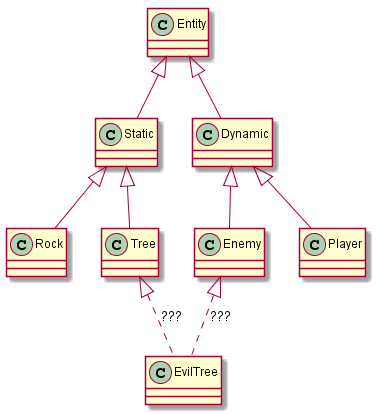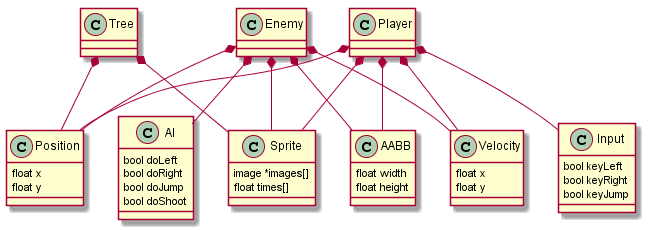【转】 Understanding Component-Entity-Systems

To solve this, game programmers started to build entities
through composition instead of inheritance. An entity is simply an
aggregation (technically a composition) of components. This has some
major benefits over the object-oriented architecture described above:
- It's easy to add new, complex entities
- It's easy to define new entities in data
- It's more efficient
Here's
how a few of the entities above would be implemented. Notice that the
components are all pure data - no methods. This will be explained in
detail below.

The Component
A component can be likened to a C
struct. It has no methods and is only capable of storing data, not
acting upon it. In a typical implementation, each different component
type will derive from an abstract Component class, which
provides facilities for getting a component's type and containing entity
at runtime. Each component describes a certain aspect of an entity and
its parameters. By themselves, components are practically meaningless,
but when used in conjunction with entities and systems, they become
extremely powerful. Empty components are useful for tagging entities.
Examples
- Position (x, y)
- Velocity (x, y)
- Physics (body)
- Sprite (images, animations)
- Health (value)
- Character (name, level)
- Player (empty)
The Entity
An
entity is something that exists in your game world. Again, an entity is
little more than a list of components. Because they are so simple, most
implementations won't define an entity as a concrete piece of data.
Instead, an entity is a unique ID, and all components that make up an
entity will be tagged with that ID. The entity is an implicit
aggregation of the components tagged with its ID. If you want, you can
allow components to be dynamically added to and removed from entities.
This allows you to "mutate" entities on the fly. For example, you could
have a spell that makes its target freeze. To do this, you could simply
remove the Velocity component.
Examples
- Rock (Position, Sprite)
- Crate (Position, Sprite, Health)
- Sign (Position, Sprite, Text)
- Ball (Position, Velocity, Physics, Sprite)
- Enemy (Position, Velocity, Sprite, Character, Input, AI)
- Player (Position, Velocity, Sprite, Character, Input, Player)
The System
Notice
that I've neglected to mention any form of game logic. This is the job
of the systems. A system operates on related groups of components, i.e.
components that belong to the same entity. For example, the character
movement system might operate on a Position, a Velocity, a Collider, and an Input. Each system will be updated once per frame in a logical order. To make a character jump, first the keyJump field of the Input data is checked. If it is true, the system will look through the contacts contained in the Collider data and check if there is one with the ground. If so, it will set the Velocity's y field to make the character jump.
Because
a system only operates on components if the whole group is present,
components implicitly define the behaviour an entity will have. For
example, an entity with a Position component but not a Velocity component will be static. Since the Movement system uses a Position and a Velocity, it won't operate on the Position contained within that entity. Adding a Velocity component will make the Movement
system work on that entity, thus making the entity dynamic and affected
by gravity. This behaviour can be exploited with "tag components"
(explained above) to reuse components in different contexts. For
example, the Input component defines generic flags for jumping, moving, and shooting. Adding an empty Player component will tag the entity for the PlayerControl system so that the Input data will be populated based on controller inputs.
Examples
- Movement (Position, Velocity) - Adds velocity to position
- Gravity (Velocity) - Accelerates velocity due to gravity
- Render (Position, Sprite) - Draws sprites
- PlayerControl (Input, Player) - Sets the player-controlled entity's input according to a controller
- BotControl (Input, AI) - Sets a bot-controlled entity's input according to an AI agent
Conclusion
To
wrap up, OOP-based entity hierarchies need to be left behind in favour
of Component-Entity-Systems. Entities are your game objects, which are
implicitly defined by a collection of components. These components are
pure data and are operated on in functional groups by the systems.
I
hope I've managed to help you to understand how
Component-Entity-Systems work, and to convince you that they are better
than traditional OOP. If you have any questions about the article, I'd
appreciate a comment or message.
A follow-up article has been posted, which provides a sample C implementation and solves some design problems. Implementing Component-Entity-Systems
Article Update Log
1 April 2013 - Initial submission
2 April 2013 - Initial publication; cleaned up formatting
29 September 2013 - Added notice of follow-up article; changed some formatting)
【转】 Understanding Component-Entity-Systems的更多相关文章
- 【转】Entity Systems
“Favour composition over inheritance” If you haven’t already read my previous post on the problems o ...
- 【转】What is an entity system framework for game development?
What is an entity system framework for game development? Posted on 19 January 2012 Last week I relea ...
- Programming Entity Framework 翻译(1)-目录
1. Introducing the ADO.NET Entity Framework ado.net entity framework 介绍 1 The Entity Relationship Mo ...
- 为什么要在游戏开发中使用ECS模式
http://www.richardlord.net/blog/why-use-an-entity-framework Why use an entity system framework for g ...
- 组件-实体-系统 Entiy-Compoent-System ECS架构整理
继承体系的问题,为什么要用ECS 面向对象的问题 当一个新的类型需要多个老类型的不同功能的时候,不能很好的继承出来 游戏开发后期会有非常多的类,很难维护 游戏中子系统很多,它们对一个对象的关注点往往互 ...
- 中间件(middlebox)
Middleboxes (also known as network functions) are systems that perform sophisticated and often state ...
- writing concurrent programs
Computer Systems A Programmer's Perspective Second Edition To this point in our study of computer sy ...
- [Angular 2] Directive intro and exportAs
First, What is directive, what is the difference between component and directive. For my understandi ...
- Why your Games are Unfinished, and What To Do About It (转)
So, you've got a new game idea, and it's going to change what everyone knows about the genre! Great! ...
- uvc摄像头代码解析5
8.初始化uvc控制 8.1 重要结构体 struct uvc_control { //uvc控制 struct uvc_entity *entity; //uvc实体 struct uvc_cont ...
随机推荐
- Android开发--环境配置
1.下载android adt和sdk adt: 新建链接http://dl.google.com/android/ADT-xx.x.x.zip下载adt 注:xx为需要下载adt的版本号,可以在官网 ...
- Java多线程-新特征-锁(下)
在上文中提到了Lock接口以及对象,使用它,很优雅的控制了竞争资源的安全访问,但是这种锁不区分读写,称这种锁为普通锁.为了提高性能,Java提供了读写锁,在读的地方使用读锁,在写的地方使用写锁,灵活控 ...
- LSM树——放弃读能力换取写能力,将多次修改放在内存中形成有序树再统一写入磁盘
LSM树(Log-Structured Merge Tree)存储引擎 代表数据库:nessDB.leveldb.hbase等 核心思想的核心就是放弃部分读能力,换取写入的最大化能力.LSM Tree ...
- [转]iOS/iphone开发如何为苹果开发者帐号APPID续费
原文地址:http://blog.sina.com.cn/s/blog_68661bd80101nme6.html 其实相当的简单,这篇内容是给财务看的,有的地方连我自己看了都感觉有点...但如果不详 ...
- linux 下crontabs使用
安装crontab:[root@CentOS ~]# yum install vixie-cron[root@CentOS ~]# yum install crontabs说明:vixie-cron软 ...
- ruby开源项目之Octopress:像黑客一样写博客(zhuan)
ruby开源项目之Octopress:像黑客一样写博客 百度权重查询 词库网 网站监控 服务器监控 SEO监控 Swift编程语言教程 今年一直推荐的一种写作方式.markdown语法快速成文,git ...
- 发送广播BroadcastReceiver
import android.os.Bundle;import android.app.Activity;import android.content.Intent;import android.vi ...
- nginx初识
- C++本质:类的赋值运算符=的重载,以及深拷贝和浅拷贝
关键词:构造函数,浅拷贝,深拷贝,堆栈(stack),堆heap,赋值运算符摘要: 在面向对象程序设计中,对象间的相互拷贝和赋值是经常进行的操作. 如果对象在申明的同时马上进行的初始化操作 ...
- Threading in C#
http://www.albahari.com/threading/ PART 1: GETTING STARTED Introduction and Concepts C# supports par ...
